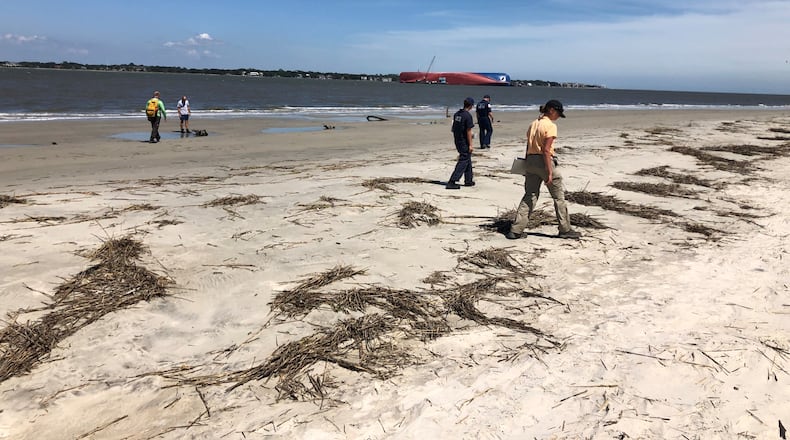Salvage operations for the Golden Ray, the 656-foot vessel that capsized off the Georgia coast last week have resumed after the threat of a tropical storm passed over the weekend.
A comprehensive plan to remove the cargo ship from the St. Simons Sound is still under development and could take weeks. In the meantime, authorities believe they have contained any fuel leaks and are in the process of removing some of the petroleum products from the vessel, said a spokesman for the recovery efforts on Tuesday.
Last Sunday, Sept. 8 the ship capsized carrying 24 crew members and 4,200 vehicles. After the vessel rolled over on its left side, a fire broke out. All crew members were eventually rescued, including four who were trapped in the boat until the following day. The Brunswick port reopened to commercial ships on a cases-by-case basis late last week, four days after the ship overturned.
Recovery efforts then turned toward containing leaking fuel and cleaning it from the surrounding waters. Part of the strategy has included placing barriers to protect the environmentally sensitive area around Bird Island and skimmers to remove oil from the water.
With the leaks contained for now, workers have shifted their efforts to removing fuel from select tanks on the ship. After ensuring the ship is safe to enter, divers will be sent in. They will tap the tanks and route the fuel to empty toward the inside of the ship, reducing the risk of polluting the water outside the vessel, said the spokesman.
>> READ MORE: Fuel vents plugged in capsized cargo ship cleanup
The objective is to remove as much fuel this way as possible. Fuel tanks with a lower risk of leaking or that could change the stability of the ship if emptied will be left alone, officials said.
A collection of state and federal organizations — including the U.S. Coast Guard and the Georgia Department of Natural Resources — along with private companies, are working together on salvage and cleanup efforts.
About 500 gallons of a mixture of oil and water have been skimmed from the water while 30 cubic yards of oil-soaked absorbent materials have been recovered, the spokesman said. There are at least 300,000 gallons of fuel, including diesel fuel and hydraulic fluid, on the ship not including fuel in the cars that are part of the ship’s cargo.
The cargo, a mix of old and new passenger vehicles from a range of manufacturers, also contains fluids such as gasoline, engine oil and antifreeze. The salvage team is working to address how it will handle the pollutants inside the ship, the spokesman said.
A team of agencies is expected to begin water quality testing this week to determine which pollutants are in the water. Ongoing air quality monitoring has revealed no impact thus far.
On Monday, assessment teams covered seven-miles of coastline and did not find any signs of oil pollution on the beach. “It is an extremely complex case and I would stress that in all its complexities...no one here has lost sight of the fact that this has impacted a local community in ways that many of us will never understand,” said the command center spokesman.
The National Transportation Safety Board, which is involved in the investigation, did not return requests for comment Tuesday.
Capt. Joe Derie, a retired Lt. Cmdr. for the U.S. Coast Guard with 30 years experience in marine investigations, said recreating these accidents in the water can be very challenging and salvage efforts are not any easier.
Large ships have a lot of dead weight and any salvage effort will likely involve pumping out all of the water before trying to right the vessel, he said. Computer simulations can also help marine salvage professionals determine the best course of action. “The people who do it are professionals,” Derie said. “You don’t get a job like that unless you really know what you are doing.”
Local environmental advocates are happy to see the response teams moving forward with removing the fuel from the ship, and they are closely monitoring the impact on the environment.
“I am making sure the impacts are documented but at the same time trying not to be an alarmist and overinflate the situation,” said Fletcher Sams of Altamaha Riverkeeper. “In the short term, we want to make sure it is documented before it can’t be and in long term, we are trying to make sure our community is kept whole through this.”
About the Author
The Latest
Featured



